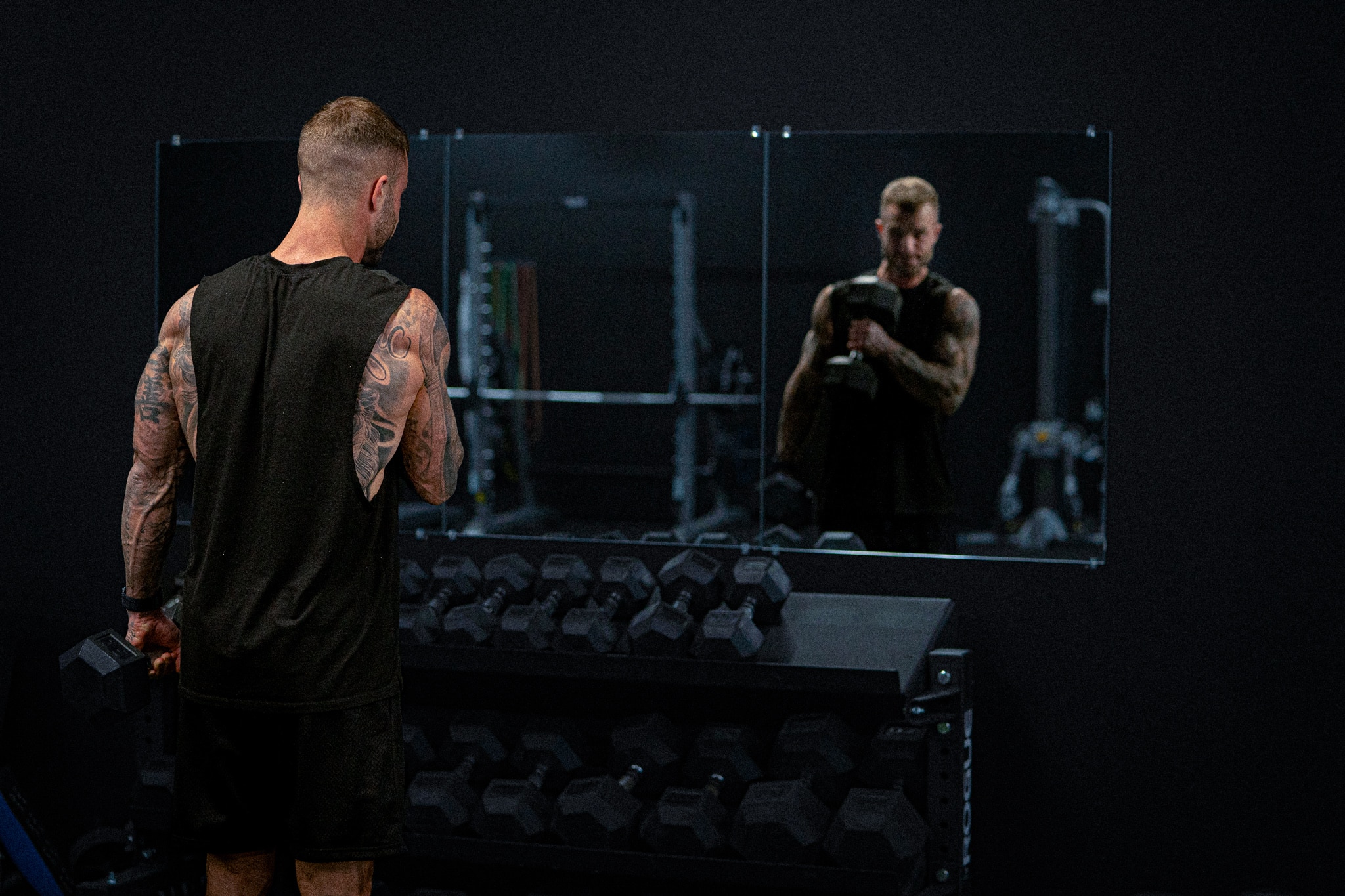An Introduction To Nutrition for Muscle Growth
When we’re thinking about gaining muscle, nutrition plays a role that is both over or underestimated. This blog serves as a guide, merging scientific insight with practical advice to optimize your diet for muscle development. Here, we’ll dissect the roles of key macronutrients and their impact on muscle hypertrophy. We’ll also cover the significance of meal timing and caloric balance, which could be used for those looking to squeeze out every drop of optimization for maximizing gains and minimizing fat accumulation. Tailoring these nutritional strategies to individual needs and goals is crucial, and this blog aims to provide you with the knowledge to do just that. Get ready to dive into the scientific principles of nutrition for muscle building and learn how to integrate these insights effectively into your life.

The Foundation for Muscle Growth: Hypertrophy Training
To build muscle, resistance training is essential – that shouldn’t be a surprise. While the optimal routine is still up for debate, a few things should be included:
- A structured program with progressive overload
- Training each muscle group at least 2-3x per week
- Training each muscle group with 12-20+ sets per week
- Finding movements that work for you
- High training intensity
- Adequate sleep (~7-8h/night)
- Avoiding injuries and life stress
If you need a structured, simplified, and science-backed training program that can guarantee muscle growth when followed consistently, start your 7-Day Free Trial with our Training App, The Tailored Trainer, today!
Scientific Principles of Nutrition For Muscle Growth
Now for the nutrition aspect. Of course, being evidence-based here at TCM we start with the science. A study by Rozenek in 2002 offers insights into how overfeeding impacts muscle growth, particularly for beginners. This study involved novices undergoing an 8-week resistance training program, divided into three groups, two of which consumed an additional 2000 kcal per day beyond their normal diet.
The primary aim of the study was to compare the impact of a supplement blend containing 356g carbohydrates, 106g protein, and 18g fat, against a supplement with a different macronutrient ratio (450g carbohydrates, 24g protein, 14g fat). This led to the protein-focused group consuming a higher amount of protein (3g/kg/day) within the same caloric surplus while the carbohydrate-focused group consumed 1.7g/kg/day of protein and the control group consumed 1.4g/kg/day. Current evidence suggests that protein consumption should be >1.6g/kg/day to maximize muscle growth. Limited evidence indicates that up to ~3g/kg/day may be beneficial, but beyond that there is no good data to suggest more muscle growth will occur.
At the end of the study, all groups gained lean body mass (a surrogate for muscle), with the carbohydrate-focused group seeing the most significant increase (+3.4kg), followed by the protein and carbohydrate group (+2.9kg), and the control group (+1.4kg). Interestingly, since these were new trainees they were able to gain lean mass and not much body fat at the same time (< 0.2 kg fat mass). These findings suggest that with a huge caloric surplus (an increase of ~50% over baseline), new trainees can gain almost twice as much lean mass, though the results should be cautiously interpreted for application to intermediate and advanced athletes because they most likely won’t apply. We also need to see more studies like this to make sure this wasn’t an outlier of a study.
Next, looking at a more advanced population, a study by Garthe et al. split athletes into two groups: one receiving nutritional counseling (NCG) and the other following an ad libitum, or free eating, approach (ALG). Both groups participated in a regular resistance training routine, coupled with their usual sports practice, totaling 16 hours per week. Their target was to achieve a weekly body weight increase of 0.7%.
Interestingly, while the nutritional counseling led to an increased caloric intake of about 500 kcal/day, only 38% of NCG athletes and 6% of ALG athletes met their weight gain objectives. Analyzing their lean body mass and fat mass gains, the NCG group added 1.7 kg of LBM and 1.1 kg of FM, translating to a 60:40 LBM-to-FM ratio. This means they were probably eating too much. In contrast, the ALG group gained 1.2kg of LBM and just 0.2kg of FM, resulting in an 85:15 LBM-to-FM ratio. The average length of time spent in a surplus was ~8 weeks for most athletes and they specifically chose body weight goals prior to the study and tried to increase body weight 0.7% per week.
This research aligns with the findings of Rozenek 2002, demonstrating that an increase in lean body mass is possible even without a caloric surplus, a fact that holds true even with extensive sports training. A notable distinction between the two groups in this study was their protein consumption. The nutritional counseling group had a higher intake at 2.4g/kg compared to the ad libitum group, which consumed 1.7g/kg. Both levels fall within the recommended protein intake range for optimizing muscle growth that was previously mentioned.
More recently, another study was published on bulking. This one was completed by Helms et al., in 2023 to evaluate the effects of resistance training (RT)-induced hypertrophy and strength improvements across three groups of resistance-trained individuals over an eight-week supervised training program, each consuming different energy intakes: (1) an approximate 15% surplus (HIGH), (2) an estimated 5% surplus (MOD), and (3) around maintenance levels (MAIN). The choice of these surplus levels was influenced by Garthe et al.’s study, which showed no significant differences in strength and lean body mass between two athlete groups with similar surpluses, yet a notable increase in fat mass in the higher surplus group. Additionally, the 15% surplus aligns with the mid-range of surplus size recommendations by Iraki et al. for off-season competitive natural bodybuilders. The 5% surplus represents a conservative approach aimed at muscle gain while minimizing fat accumulation.
Once per week, each participant would check in with their nutrition supervising researcher. For each check-in, participants were instructed to verify accuracy for their spreadsheet where they recorded their weight, energy, protein, fat, and carbohydrate intake each day. However, no nutrition data or macronutrients were reported in the study results so we don’t know how much of a surplus they were in.
The study also had several limitations. For example, participants only trained full body three times per week, although they did have adequate training volume for the biceps (18 sets per week). The group assignment was based on the target energy surplus; however, despite competent and consistent monitoring, the intended energy surpluses were not consistently followed by all participants. The key outcome of the study revealed that the only significant and notable increase in muscle size across all three groups occurred in the biceps, with an average growth of approximately 0.2–0.3 cm. However, the validity of these results is somewhat constrained by the study’s small sample size, a limitation brought about by the COVID-19 pandemic.
As you can see, the studies on overfeeding and gaining muscle in a caloric surplus are few and very different. This makes it really difficult to make evidence-based recommendations.

Do You Need A Caloric Surplus For Muscle Growth?
Based on the studies we covered in our previous section, it appears that a larger caloric surplus may be beneficial in the initial stages of one’s training career but are not required. However, maintaining a balance and focusing on lean body mass gain has its advantages too. As one progresses to more advanced training levels, the potential for muscle growth nears its genetic limit, making further gains more challenging and slower. Prioritizing injury prevention and training that works for the individual is key. Additionally, for physique athletes in and after competitive seasons, significant muscle gains are unlikely during the competition period and the subsequent 2–3 months, as it takes time for their physiology to normalize.
A useful guideline is for beginners to aim for a weekly weight gain of 0.5% of their body weight, averaged monthly, and for advanced lifters to target about 0.25% of body weight per week. This approach suggests conservative energy surpluses, adjusted according to resistance training experience, ranging from 5–20% above maintenance energy needs or targeting rates of weight gain of 0.25–0.50% of body mass weekly.
Planning Your Calorie Surplus For Muscle Growth (Case Study Example):
For a typical person, a building phase should last at least 12-16 weeks. This phase should be paired with as much training volume as the individual can handle, potentially interspersed with caloric maintenance weeks to prolong the gaining season. Considering someone who is an intermediate trainee and eats ~2000 kcal per week at maintenance, an example approach could be:
- Weeks 1-4: +150 kcal surplus per day
- Weeks 5-6: Maintenance phase
- Weeks 7-11: +200 kcal surplus
- Weeks 12-15: Maintenance phase
- Weeks 16-20: +250 kcal surplus from baseline
- Weeks 20-24: Maintenance, followed by evaluation and adjustments.
The maintenance phases are placed so that the surplus phase can be extended to maximize gaining muscle. They aren’t needed, but ideally, we want to spend more time at maintenance or in a surplus than we are dieting in a single year (except for contest preps).
The surplus required to gain weight likely varies based on a person’s lifestyle, job, and training program, which is why we recommend using body weight as the main metric when bulking and adapting calories as needed to hit that goal.
Commonly Asked Questions About Nutrition For Muscle Growth:
Question: What are your views on implementing calorie cycling in a surplus phase, specifically consuming higher or surplus calories on workout days and maintaining calories closer to the baseline on rest days?
- Calorie cycling might be effective in reducing fat accumulation, but its impact on muscle building is uncertain, as recovery and adaptation primarily occur post-exercise. For those aiming to maximize muscle growth, you should ideally be 5-6 times per week, which would limit the implementation of calorie cycling. Furthermore, there is a lack of scientific research specifically addressing calorie cycling during a caloric surplus.
Question: What is the ideal monthly total weight gain target for someone looking to build muscle while on a caloric surplus?
- My broad recommendation is to aim for a weekly weight gain of 0.25-0.50%
Question: During a period of caloric surplus, is it typical to see variations in the rate of weight gain, such as a faster initial gain that gradually slows down over time, assuming consistent adherence to the plan?
- It’s common to observe some linearity in weight gain over time during a surplus period, but it’s also possible to encounter plateaus that might last a month or so. While scientific evidence on this specific aspect is limited, an increase in gym performance coupled with weight gain generally indicates a well-managed surplus. If both these factors are progressing positively, it suggests that the approach to the surplus is effective.
Question: After a competition, what indicators should one look for to know they’ve moved from the recovery phase to the muscle-building phase, especially considering the need for initial weight gain but also the desire to focus on muscle growth rather than unnecessary fat gain?
- Post-competition, muscle gain can be challenging due to hormonal and physiological shifts. The primary focus should immediately be on recovering health and well-being, which will involve gaining body fat. For instance, in my personal experience, I transitioned from 170 to 140 pounds during competition, and within three weeks post-competition, I increased to 150 pounds. After another 3-4 weeks, reaching 155 pounds and feeling healthier, I began a gradual increase to 165 pounds over the next 12-16 weeks, maintaining that weight with minor cut/gain cycles for several years. Rapid weight gain right after a competition tends to result in more fat gain (i.e., body fat overshooting). A good benchmark is to regain approximately 20-30% of the lost weight to reach a healthy state. For female athletes, reestablishing a normal menstrual cycle should be a primary goal in the post-competition phase.
Question: In the context of monitoring progress, is it advisable to track all measurements, or should the focus be primarily on bodyweight, photos, and performance metrics?
- Tracking all measurements is beneficial. However, if clients find photo tracking discouraging, it’s reasonable to exclude that aspect. Consistently monitoring body weight, ideally 3-4 times a week, is crucial for obtaining a reliable indication of whether the training and nutrition plan is on the right track.
Question: Does training intensity influence muscle hypertrophy in a surplus?
- The most recent meta-analysis on the relationship between proximity to failure and hypertrophy, while the effect size (ES) was trivial to small (0.19), hypertrophy was significantly greater in groups that trained to failure. However, nutrition wasn’t analyzed as a factor. It would make sense that training close to failure will improve results.




















































































































































































































































































































































































































































































